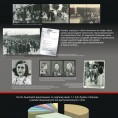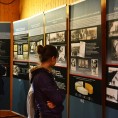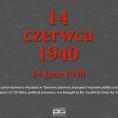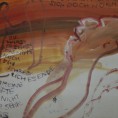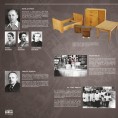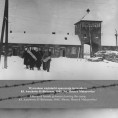Volunteers of the Memorial honoured with the awards “If Not for Those Ten... ”
Seminar in collaboration with the academic centre for oral history in Voronezh
International Summer Academy 2019 in English and German - Call for Participants
Educational challenges in authentic memorial sites
Exhibitions
Exhibitions designed by the Museum are a very valuable form of education about Auschwitz and the Holocaust. This is also an important part of creating opportunities for those who have not had the opportunity to make a personal visit or learn about the subject in other ways.
Several hundreds exhibitions have been held, which were shown in such countries as: Austria, Belgium, Germany, Hungary, Italy, Israel, Japan, The Netherlands, Poland, Russia, Sweden, Switzerland, the UK and the USA.
Auschwitz, Memory, World
Open-air exhibition entitled "Auschwitz, Memory, World", has been prepared on the occasion of the 65th anniversary of the creation of the Auschwitz-Birkenau State Museum. The sites of the former German Nazi concentration and extermination camp Auschwitz was visited in this period by tens of millions of people, among them renowned representatives of the world of politics, culture, religion and science. The exhibition presents the most outstanding personalities who visited this place on behalf of their nations and states to pay tribute to the victims of the camp.
Graphic design: Robert Płaczek
Forbidden Art
The exhibition entitled “Forbidden Art” presents in an appealing way camp art created illegally by prisoners in spite of the suffering and crimes, as an expression of revolt and escape from the nightmarish reality surrounding them to a creative act and the beauty resulting thereof. The presented works include various forms of art: painting, drawing, sculpture, metalwork, and literature.
Author of the exhibition: Agnieszka Sieradzka
Project of FPI-designe
German Nazi Death Camp Konzentrationslager Auschwitz
Historical exhibition entitled "German Nazi Death Camp Konzentrationslager Auschwitz", presents the most important history of the camp, and the genesis of the Nazi movement as well as the specific nature of German occupation on Polish lands. The main emphases were placed on the reasons for founding the camp and the political background of its operation; the process of extermination of the Jews; various forms of extermination, the conditions of living and employment of prisoners; the forms of resistance and aid provided to the prisoners from outside. Separate display-boards present detailed groups of victims such as women, the Roma, children or Soviet prisoners of war.
The Italian language version contains a display-board presenting the deportations of Italian citizens to KL Auschwitz.
The exhibition is based on source and iconographic materials of the Auschwitz-Birkenau State Museum.
Scenario and choice of materials: Mirosław Obstarczyk
Project and graphic design: Piotr Kutryba
The Museum has exhibitions in the following languages: Polish, English, German, Russian and Italian.
In addition, the exhibition is available for printing in electronic version in Chinese, Korean and Swedish.
German Plans for Auschwitz Redevelopment
Historical exhibition titled "German plans for Auschwitz redevelopment", presents, based on plans, architectural drawings and documents, the German vision of transforming the Auschwitz concentration camp into a huge complex of camp barracks and the reconstruction of the city of Auschwitz to the German model of an industrial city. The exhibition was created in Polish and English, based on materials from the Archive of the Auschwitz-Birkenau State Museum and the State Archive in Katowice.
Scenario and choice of materials: Teresa Zbrzeska
Project and graphic design: Robert Płaczek
June 14, 1940
Historical open-air exhibition entitled "14 June 1940", presents the profiles and fates of 728 Poles, registered on that day as the first political prisoners in the German Nazi Auschwitz camp. The date of arrival of the transport from Tarnów prison is acknowledged as the start date of the camp. The exhibition contains a list of names and camp photographs or civilian prisoners, as well as short biographies of selected persons.
Scenario and choice if materials: Mirosław Obstarczyk, Teresa Zbrzeska
Project and graphic design: Elżbieta Pietruczuk
Leben? Oder Theater? Charlotte Salmon 1917-1943
„Leben? Oder Theatre. Charlotte Salomon, 1917-1943” - the exhibition of gouaches by Charlotte Salomon, a German artist of Jewish origin, consists of 66 copies of work from the series “Life? Or theatre?”, with 1,300 works. The autobiographical work illustrates the tragic vicissitudes, fears and dilemmas of the artist, who was killed in Auschwitz at the age of 26. The originals are found in the Museum of the History of the Jews in Amsterdam.
People of Good Will
Open-air exhibition entitled "People of good will" is an expression of tribute to the Poles, inhabitants of German-occupied Oświęcim (Auschwitz) and nearby towns who risked their lives in providing aid to the prisoners of the German Nazi Auschwitz camp; saved them during the evacuation marches or cared for the survivors after the liberation of the camp. Many of them were murdered or imprisoned in the camp for these activities. The exhibition describes the various forms of aid giving to prisoners as well as biographies of persons particularly involved in the relief effort. The exhibition has been prepared in Polish and English based on source and iconographic materials of the Auschwitz-Birkenau State Museum.
Scenario and choice of materials: Mirosław Obstarczyk, Teresa Zbrzeska
Project and graphic design: Elżbieta Pietruczuk
Residents of Insurrectionary Warsaw
Open-air exhibition entitled “Residents of Insurrectionary Warsaw at KL Auschwitz" presents on the example of selected families, the fate of the 13 thousand Warsaw inhabitants – men, women and children deported to the German Nazi Auschwitz camp during the Warsaw Uprising. We see from their fate, a connection with two of the biggest tragedies of the Polish nation, which occurred during the II World War. The exhibition was created in Polish and English, based on the resources of the Auschwitz-Birkenau State Museum’s Archive and private collections.
Scenario of the exhibition and the choice of materials: Helena Kubica, Teresa Zbrzeska
Project and graphic design: Elżbieta Pietruczuk
So I Come and Kneel at this Golgotha of the Modern World
The exhibition entitled “So I am here kneeling down upon this Golgotha of modern times ...” presents unique photographs of Henryk Makarewicz and Stanisław Mucha, taken in the first days and weeks after the liberation of the camp. The photographs are shocking in their horror and authenticity. They are complemented by entries to the Museum’s commemorative book written by outstanding personalities during visits to the sites of the former camp. The exhibition has been prepared in Polish and English based on the resources of the Auschwitz-Birkenau State Museum’s Archive.
Scenario and choice of materials: Robert Paczki, Teresa Zbrzeska
Project and graphic design: Damian Daszkiewicz
Traces of them remain
Historical exhibition entitled “Traces of them remain” Auschwitz was not only a centre of mass extermination of the Jews and martyrdom of the camp inmates, but also a place of collective executions by shooting, carried out on the local population. I have been following the fate of Poles; prisoners of the gestapo, who waited in the camp jail in Block 11 of the Auschwitz I camp for the SS Police Summary Court, and later for execution. Drawings and inscriptions left by the victims on the walls of the cells, doors and floor beams or window sills are their last farewell to the world. The exhibition is presented in Polish and English.
Scenario and choice of materials: Adam Cyra, Teresa Zbrzeska
Project and graphic design: Edyta Chwistek, Elżbieta Pietruczuk
The Liberation of KL Auschwitz
Open-air exhibition entitled "The liberation of the KL Auschwitz concentration camp" consists of 28 large-format photographs from the Archives of the Auschwitz Museum, documenting the first days and weeks after the liberation of the camp. They mainly present survivors and the medical staff of the Red Army and the Polish Red Cross, as well as the inhabitants of the neighbouring areas bringing aid to the prisoners. The exhibition has been prepared in Polish and English.
Exhibition scenario: Mirosław Obstarczyk, Teresa Zbrzeska
Project and graphic design: Elżbieta Pietruczuk
The Memory of Auschwitz
The exhibition entitled "The Memory of Auschwitz" is a presentation of the artistic reflection of Polish youth about Auschwitz, expressed in the form of posters submitted for the competition announced by the Museum on 55th anniversary of the liberation of the camp. Pupils of secondary schools of art from all over Poland took part in the competition.
Women at KL Auschwitz
Historical exhibition entitled "Women at KL Auschwitz". The situation of women imprisoned and murdered in the camp was particularly tragic for various reasons. The exhibition dedicated to their memory illustrates the tragedy of fate, suffering and heroism of the prisoners in the struggle for survival and preservation of dignity in the German Nazi concentration camp, as well as the martyrdom of the Jewish women murdered in the gas chambers. It presents the most important history of the female camp, i.e. its genesis, the extermination of Jewish women in the gas chambers, the organization of the camp and its crew; the structure of the prisoners’ nationalities with particular emphasis on the Jewish, Polish, and Roma women; hunger, living conditions, diseases, employment, terror, punishment and medical experiments, motherhood, resistance and escapes, as well as the role of women from the neighbouring areas in the conspiratorial action to provide aid to the prisoners. The exhibition has been prepared in Polish and English based on source and iconographic materials of the Auschwitz-Birkenau State Museum.
Scenario and choice of materials: Mirosław Obstarczyk
Project and graphic design: Elżbieta Pietruczuk


















